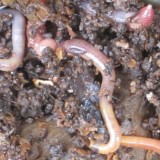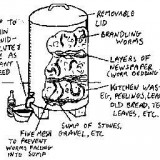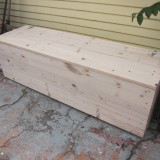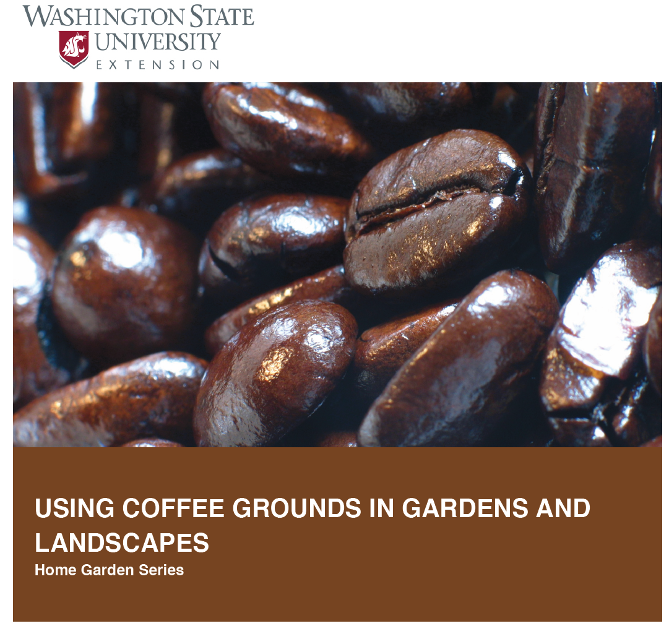
Image source: Philip Cohen, Wikipedia.
This past weekend I taught a composting class at a local Waldorf school to a group of adults. When I asked the students to describe their living situations, I realized I needed to take a detour from the main activity of the day, building a large biodynamic compost pile, into a discussion of worm composting.
Why? A few of the attendees lived in apartments or had very small yards. The type of composting your household does will be determined in part from how you manage your waste stream and what you intend to do with the compost. If you live in an apartment and just have a few house plants, a worm bin is going to be your best option.
Even if you have a yard and a vegetable garden you may still need to maintain a few different types of compost methods. We have three kinds of composting methods at our house, determined by the types of waste streams our household generates:
Worm bin
Our worm bin is for the trickle of food waste that comes out of the kitchen on a daily basis. This consists of vegetable trimmings, tea bags and coffee grounds.
Advantages: Can be done indoors in an apartment. Produces a compost that is higher in nutrients than a conventional compost pile.
Disadvantages: Certain foods can’t be added like citrus and onions.
Conventional compost pile
If you have a vegetable garden and want to grow organically, you’ll need to generate a large amount of compost. This is a great way to deal with yard trimmings, grass, manure, and food waste.
Advantages: makes the kind of high quality compost needed in large quantities for a vegetable garden.
Disadvantages: a lot of work, can’t be added too once the pile is built, may require car trips to gather materials.
“Disposal” compost pile
There’s also stuff that can’t go in the worm bin. And once you build a big pile it’s best not to keep adding to it. For this reason we have a kind of “disposal” pile. It’s a compost bin that gets the materials that can’t go into the other two.
Advantages: reduces the biomass of all the stuff that can’t go either in the worm bin or the big compost pile.
Disadvantages: produces a low quality compost.
Alternatives
The labor involved in building a big compost pile for a conventional vegetable garden speaks to the advantages of what I think of as alternative permaculture food crops. In our climate that’s things like prickly pear cactus, pomegranates, certain types of grapes, olives and California natives (many of which are edible or medicinal). These useful plants don’t need compost. They pull up nutrients from the ground and, if you let the leaves fall in place, do their own composting.






Don’t forget bokashi composting system. Great for any size: apartment or large facilities. Composting all food waste and even paper.
Can make your own “bokashi mix” also- no need to buy. Aloha.
Thanks for bringing bokashi up. A friend of ours used to give me his bokashi waste to incorporate into my compost pile. And Aloha to you too!
If you don’t get upset about weed seeds you can have a pretty low-key compost system that soaks up garden and yard waste, kitchen scraps and anything else you care to add. Turn it every once in a while, try not to leave food on top, and expect it to slow way down in winter. If you let it season for a year, a good chunk of the weed seeds will sprout and die, and you’ll get compost 95% as good as high-maintenance systems, for basically no work.
I know you’re pretty intense about compost, but there is a huge spectrum from just throwing kitchen waste out the window all the way to thermophilic piles that are carefully formulated and built in batches and so on. Most of the time it’s pretty easy to fall in the middle.
Thanks Ben–I’ve got a pile going just like the one you describe. One funny thing about it–I put it near our bedroom and put a lot of brew waste into it. Combine that with a fan in the window . . . not one of my better ideas!
Haha, oops! I did the same thing earlier this summer with our neighbor’s grass clippings. It smelled like grass clippings inside for a few days. The good thing about either one of those is that they heat up and go away quick!
Don’t forget chickens. For my money a chicken run is the best sort of compost pile. Chuck in anything, making sure to add plenty of woody/carbon-rich/brown materials. Chickens aerate by scratching, spread moisture/nitrogen rich poop, and stuff breaks down really fast. I just shovel it out and sieve it before putting on beds.
For grass clippings and other yard and garden and sludge from our sewage disposal I start with a clay pile and then keep adding the clippings, etc to it over the course of a year or two. I turn it with my bobcat on a regular basis and then after it looks to be about the right mix I don’t add anymore for a few more years but continue to turn it to keep weeds out and help the composting action. And then at the end I have soil that is good for gardens, flower beds, landscaping or whatever I want.
Thanks for the reminder to design our compost piles appropriately for their use! I was just thinking about this.
We designed a large 3 bin system at our community garden at the local university, which includes 2 additional “heap” areas for leaves, as a partnership to accept food waste from the university departmental kitchens. But participation by the departments didn’t pan out, and now we have a system that doesn’t match our waste stream, which is just garden waste. The bins are mostly empty after more than a year of being up.
Also, at home, our 3 bin system is perfect for our waste stream, but over the winter we added a worm bin. We forget about it a lot. I kind of feel bad for the wormies in there. I need to put in that board you guys use to mentally separate one side from the other. I just willie-nillie throw food waste in and it’s not going to work for harvesting and keeping tabs on their wellbeing as far as bedding and moisture levels.
I’ve never heard that you couldn’t put onions or citrus into my worm bin. I’ve had mine for about 5 years and put all manner of things in there. The bin moves with me from apartment to apartment and I’ve never had problems. The only thing I’ve been told to avoid is newspaper because of the clay content in the paper and the chemicals in the inks. Do you have the article or anything regarding the exclusion of onions and citrus?